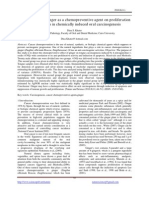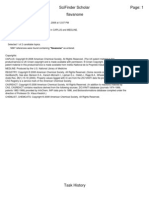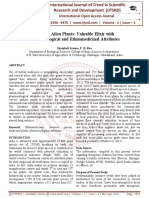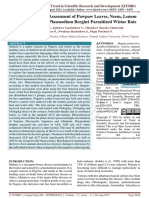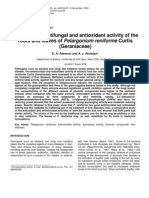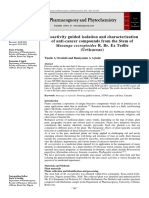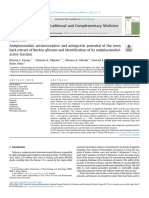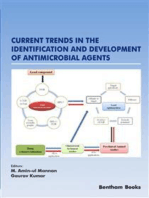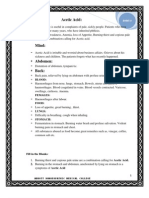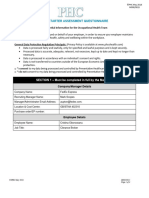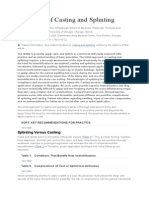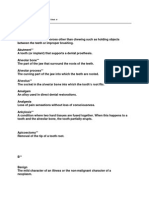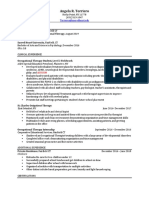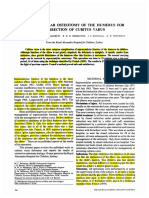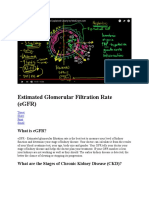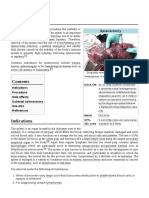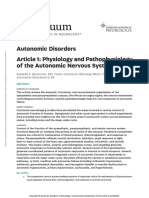Professional Documents
Culture Documents
Phyllanthus Amarus and Euphorbia Hirta On Benzo
Original Title
Copyright
Available Formats
Share this document
Did you find this document useful?
Is this content inappropriate?
Report this DocumentCopyright:
Available Formats
Phyllanthus Amarus and Euphorbia Hirta On Benzo
Copyright:
Available Formats
Volume 6, Issue 4, April – 2021 International Journal of Innovative Science and Research Technology
ISSN No:-2456-2165
Chemopreventive Potential Of Aqueous Extracts Of
Phyllanthus amarus and Euphorbia hirta On Benzo
(a) Pyrene Induced Lung Cancer In Albino Mice
Onoja, A. O*1,2., Edogbanya, P. R. O3., Egbeja, T. I1., Olasunkanmi M. O1., Shuaib J1.
1
Department of Animal and Environmental Biology, Kogi State University, Ayingba, Nigeria.
2
Cell Biology and Genetics Unit, Department of Zoology, Faculty of Sciences, University of Ibadan, Nigeria.
3
Department of Plant Science and Biotechnology, Kogi State University, Ayingba, Nigeria.
*Corresponding Author: Onoja, A.O, Department of Animal and Environmental Biology,
Faculty of Natural Sciences, Kogi State University, PMB 1008, Anyigba, Nigeria.
Abstract:- Lung cancer, amongst other forms of cancer hirta > P.amarus and E. hirta) while Cardiac glycoside
is heterogeneous diseases with diverse morphological have the lowest concentration (0.19 ± 0.00, 0.17 ± 0.00,
appearances as well as chemotherapeutic responses due 0.31 ± 0.01; P.amarus and E. hirta > P.amarus > E. hirta).
to associated significant limitations in safety and The haematological parameter reveals a slight increase
efficacy. The major risk factor for lung cancer is tobacco in WBC and LYM in the treated groups which indicates
which accounts for 25–30% incidence and 71% of global the strengthening of the defense mechanism as well as
lung cancer-related deaths. Tobacco contains Polycyclic immune response of the organism towards B(a)P
Aromatic Hydrocarbons (PAHs) carcinogens such as induced cell proliferation. The histological sections of
benzo(a)pyrene (B(a)P) which can be activated by a P- lung tissue revealed the presence of vessels with mild and
450 enzymes and covalently bind to DNA at specific sites focal lesions in the treated animal groups suggesting the
to form bulky adducts preceding mutation, extracts curative and suppressive effects to the
carcinogenesis, apoptosis or nucleotide excision repair proliferating cell-tissue and damages induced by B(a)P.
system error. Several plant materials have been This study has shown that the extracts of P. amarus and
considered as effective in cancer chemoprevention with E. hirta could be used as a prophylactic against B(a)P-
negligible or no side effects. This current study was induced cell proliferation in the lung tissues of mice. It
aimed at determining the Chemopreventive potentials of also identifies new areas of research for development of
aqueous extracts of the whole plant of Phyllanthus better therapeutic and chemopreventive agents against
amarus and Euphorbia hirta on B(a)P-induced lung cell carcinogenesis and other infectious diseases. Lastly, this
proliferation in albino mice based on selected indices study serves as a resource base for more research on
(phytochemical screening, heamatology and molecular indices, biochemical screening and isolation of
histopathology). P. amarus and E. hirta, Forty (40) active compounds to determine the therapeutic and
Pathogen free Swiss albino mice weighing 16g-23g and chemoprevention efficiency of the plants in lung cancer
B(a)P were used for the study. Decoction extraction treatment in human.
method was employed in the preparation of aqueous
extract of P. amarus and E. hirta whole plants. Keywords:- Lung cancer, B(a)P, Phyllanthus amarus,
Quantitative phytochemical screening of aqueous whole Euphorbia hirta, chemoprevention, histopathology.
plant extract was employed using standard procedure.
The mice were blindly divided into eight (8) groups I. INTRODUCTION
consisting of five mice (n=5) each per group. The first
two groups are controlled groups (positive PC and Cancer is a disease of abnormal gene expression
negative NC) the PC received 20mg/kg B(a)P once characterised by multistage mechanistic process of DNA
weekly while other groups received 20mg/kg B(a)P once insults and abnormal gene transcription or translation
weekly and 50mg/kg, 100mg/kg and 200mg/kg extracts culminating in cell function defects and tumorigenesis.
respectively once daily through oral gavaging. Haemo- Carcinogenesis initiation involves an alteration in a cell
analyzer was used to analyze blood sample collected by DNA due to carcinogens or damage to a DNA repair
cardiac puncture into a pre-labeled EDTA sample mechanism. During promotion, the mutant cell reproduces
bottles for WBC, LYM, NEUT and BAS while abnormally by asexual reproduction to forms a population of
haematoxylin and eosin method were used for highly proliferative tumor cells outnumbering their normal
histological assay. The quantitative phytochemical cell counterparts (Pezzuto et al., 2005; 2006) in other words,
analysis reveals the presence of some secondary carcinogenesis involves uncontrolled cell growth resulting
metabolites, alkaloids, flavonoids, saponins, tannins, from the activation of oncogenes and/or the deactivation of
cardiac glycosides and total phenols. Total phenol was tumor suppression genes, leading to dysregulation of
found to be present in the highest concentration (1044.17 cellular differentiation, excessive proliferation and
± 0.78, 2015.25 ± 0.01, 1859.12 ± 0.01; P. amarus > E.
IJISRT21APR354 www.ijisrt.com 942
Volume 6, Issue 4, April – 2021 International Journal of Innovative Science and Research Technology
ISSN No:-2456-2165
resistance to apoptosis (Hanahan and Weinberg, 2011;
Sibaji et al., 2013). The medicinal healing power of plants had been
recognized since creation and botanical herbal medicine is
The most common sites for carcinoma include lung one of the oldest practiced professions by mankind (Hugo
cancer, breast cancer, prostate cancer, cervical cancer, and Russell, 2003). Medicinal plants have been found useful
colorectal cancer, and stomach cancer (IARCGlobocan, as anti-sickling, anti-malarial, anti-microbial, anti-
2008). IARC estimates provide a breakdown of the leading convultant, anti-helmintic, anti-hypertensive, and
sites of cancer deaths. These include cancer of the lung molluscidal agent (Prescott et al., 2002). The curative
(approximately 1.4 million deaths each year), stomach potentials of these plants are locked up and embedded in
(740,000), liver (700,000), colorectal (610,000), breast some chemical components that effects physiological
(460,000), cervix (275,000) and prostate (260,000); showing response in man (Edeoga et al., 2005). Polyphenolic
that lung cancer is the most diagnosed cancer cases and the compounds have been attributed to the plant
leading cause of cancer-related death worldwide in both chemopreventive properties with higher anticancer treatment
sexes. Tobacco consumption a major risk factor for lung potentials. Many pharmaceutical industries depend on plant-
cancer accounts for 25–30% incidence (Bray et al., 2018) based products for medicaments in the treatment of various
and 71% of global lung cancer deaths attributable to tobacco cancer/ailments (Abraham, 1981) for instance; four classes
(WHO, 2009). Tobacco is a multi-organ carcinogen causing of plant-derived anticancer agents are vinca alkaloids
oral, liver, bladder, pancreatic cancers and leukaemia (vinblastine, vincristine and vindesine), epipodophyllotoxins
(Danaei et al., 2005) because it contains Polycyclic (etoposide and teniposide), taxanes (paclitaxel and
Aromatic Hydrocarbons (PAHs) carcinogens such as docetaxel) and camptothecin derivatives (camptotecin and
benzo(a)pyrene (B(a)P) and the tobacco-specific irinotecan) (Taneja and Qazi 2007). Plants still have
nitrosamine known as nicotine-derived nitrosoaminoketone enormous potential to provide newer drugs and as such are a
(NNK) which can be activated by aniline hydroxylase, a P- reservoir of natural chemicals that may provide
450 enzymes and might bind covalently to DNA at specific chemoprotective potential against cancer. The World Health
sites to form bulky adducts preceding apoptosis or Organisation (WHO) (2002a,b; 2009) estimate that more
nucleotide excision repair system error (Gazdar, 2007). than 80 percent of the world population relies on traditional
However, most common cancers does not develop overnight herbal medicines as their first source of health care due to
but takes gradual process often evolving over many months their pharmacological properties and about 85 percent of
and/or years before DNA mutations accumulate and result such traditional medicine used have compounds derived
into a detectable premalignant lesions presaging the from medicinal plants extracts. Phytochemical molecules
development of full blown malignant cancer (Bennett et al., from natural products such as alkaloids, flavonoids, tannins
1999; Klein, 2008). Any chemical compounds capable of and phenols capable of exerting a physiologic action on the
preventing, blocking or reversing these processes and/or human body forms the effective ethno pharmacological
inhibits cellular events associated with tumor initiation, information in the discovery of new anti-infective agents
promotion, and progression are potential candidates for from medicinal plants (Duraipandiyan, et al., 2006).
cancer chemoprevention (Pezzuto, 1993; Kinghorn et al., However, such plants should be investigated to better
2004). Chemoprevention, the most direct ways to reduce understand their properties, safety, and efficiency.
morbidity and mortality involves the prevention of cancer
by ingestion of chemical agents which can reduce the risk of The aim of this study is to determine the
carcinogenesis. Chemopreventive potentials of aqueous extracts of the
whole plant of phyllanthus amarus and Euphorbia hirta on
The Plants kingdom provides an enormous potential Benzo(a)pyrene induced lung cell proliferation in albino
for newer plant-based chemical compounds that can be used mice based on selected indices such as phytochemical
in chemopreventive approach against cancer (Taneja and screening, heamatology and histopathology in order to
Qazi 2007). Plant based chemotherapeutic agent acts by determine the efficiency of these extracts in the management
killing cells that divide rapidly, which are characteristic of of lung cancer in human.
most cancer cells. Medicinal plants used in traditional
medicine have over the years contributed many novel Phyllanthus amarus is a small, erect, annual herb
compounds for preventive and curative medicine to modern belonging to the family Euphorbiaceae, having large number
science (Desai et al., 2008; Umadevi et al., 2013), because of phytochemicals that are attributed to its leaves, stem and
most chemotherapeutic treatments have be reported for roots. P. amarus is used in Thai folk medicine for the
various kinds of toxicities and intrinsic problems (Desai et treatment of fever, jaundice, ascites, heamorrhoid and
al., 2008). Therefore, there is demand for an alternative diabetes (Pongboonrod, 1976). Several reports also showed
medicine for the treatment of cancer. Herbal medicines have that P. amarus had anti-hepatitis B virus effect (Thyagarajan
received greater attention worldwide as alternative to et al., 1988), hypoglycemic effect (Moshi et al., 1997),
clinical therapy in recent times leading to subsequent antinociceptive effect (Santos et al., 2000), the increase in
increase in their demand (Sushruta et al., 2006; Ogbonnia et life span of rats with hepatocellular carcinoma
al., 2010). Medicinal plant products usage in the (Rajeshkumar and Kuttan, 2000), antitumour, antimutagenic
management or arresting the carcinogenic process offers an and anticarcinogenic effect (Sripanidkulchai et al. and
alternative to the use of allopathic conventional medicine for Rajeshkumar et al., 2002), anti-inflammatory effect (Kiemer
treatment of the disease. et al., 2003; Kassuya et al., 2006) and chemoprotective
IJISRT21APR354 www.ijisrt.com 943
Volume 6, Issue 4, April – 2021 International Journal of Innovative Science and Research Technology
ISSN No:-2456-2165
effect (Kumar and Kuttan, 2005), anti-bacterial (Mazumder Department of Animal and Environmental Biology, Kogi
et al., 2006, Melendez and Capriles, 2006, Oliveira et al., State University, Anyigba, and housed in a neat and well
2007), anti-parasitic (Zirihi et al., 2005, Hout et al., 2006), ventilated plastic cage. Their bedding which was of saw dust
anti-viral (Venkateswaran et al., 1987, Yang et al., 2005, was regularly changed and they were supplied with
Balasubramanian et al., 2007), anti-oxidation (Bhattacharjee commercially pellet Feed and drinking water ad libitum. The
and Sil, 2007, Chatterjee and Sil, 2006, Kumaran and animals were exposed to 12h periodic lights.
Karunakaran, 2007), hypoglycaemic properties (Lawson-Evi
et al., 1997), antispasmodic properties (Gbeassor et al., Tumor induction
1988). Lungs tumors were induced by a freshly prepared
single dose of 20 mg of B(a)P weekly diluted in distilled
Euphobia hirta is a slender- stemmed, annual hairy water and given by oral-gavage method as described by
plant belonging to the family Euphorbiaceae, used in Alfredo et al., (2004) and Minari et al., (2016). All the
traditional medicines ingredient as arrow poisons. E. hirta albino mice received the chemical carcinogen once every
possesses antibacterial, anthelmintic, antiasthmatic, week for the period of the experiment. Exposures to B(a)P
sedative, antispasmodic, antifertility, antifungal, has been reported to induce tumor or implicated for
antimalarial, antioxidant, anti-inflammatory and anti-cancer development of lung cancer in animal species such as mice
properties (Basma et al., 2011). (IARC, 2010).
II. MATERIALS AND METHODS Experimental design
The study was designed in accordance with the
Collection and identification of plant materials procedures provided by Builders et al., (2012), Rajina and
Whole fresh Plants of P. amarus, and E. hirta were Shini (2013) and Onoja et al., (2019). The animals were
collected from the Biological Sciences Garden, Kogi State made to fast over-night prior to drug administration to allow
University, Anyigba, Nigeria between July and September, fast cellular absorption. The B(a)P and tested plants
2019. The plants were taken in separate polythene bags to constituent were administered to animals in a sequential
the herbarium, Plant Science and Biotechnology routine using syringe and canula via oral route. The animals
Department, Kogi State University, Anyigba for were blindly divided into eight (8) groups consisting of five
identification by a taxonomist. The plants were cleaned of mice (n=5) each per group. The first two groups are
extraneous matter, and the necrotic parts were removed and controlled groups while the others are received
washed with clean water then air-dried for two weeks. Equal homogeneous suspensions of the B(a)P once weekly and
weight of the air-dried plants parts were measured and extracts once daily through oral gavaging for three (3)
coarsely milled separately into powdery form using a weeks.
milling machine for easy extraction. Negative Control (NC): Control Animals treated with
distilled water only.
Preparation of Aqueous Plant Extracts Positive Control (PC): Animals treated with 20mg/kg
The grounded plants were subjected to decoction B(a)P once per week.
extraction method as described by Yadav and Agarwala Group I (P. amarus (PA) and E. hirta (EH)
(2011) with little modifications. 200g each of ground P. respectively): Animals treated with 20mg/kg B(a)P
amarus and E. hirta were soaked in 2 litres of deionized weekly and 50mg/kg Extracts daily.
water and boiled for 10 minutes separately. The decoctions Group II (P. amarus (PA) and E. hirta (EH)
were initially filtered using a sieve mesh and the filtrate was respectively): Animals treated 20mg/kg B(a)P weekly
further sifted using cotton wool and finally using and 100mg/kg Extracts daily.
Whatman® no.1 (11μm) filter paper. The filtrate of each Group III (P. amarus (PA) and E. hirta (EH)
preparation mixture was concentrated under standard respectively): Animals treated with 20mg/kg B(a)P
temperature and pressure using a water bath evaporator at weekly and 200mg/kg daily.
100°C to obtain a semi-solid form of the crude extract which
was then stored in an air tight container and refrigerated at Blood Sample Preparation and Haematology parameter
4°C until use. At the expiration of the experiment, Blood sample was
collected by cardiac puncture from the animals into a pre-
Phytochemical screening of the plants extract labeled sample bottles containing ethylene diamine
The aqueous extracts of P. amarus and E. hirta were tetraacetic acid (EDTA) and was shaken gently to mix the
used for quantitative phytochemical screening for the sampled blood with EDTA to avoid clotting. The samples
presence of secondary metabolites as per the standard were analysed for the White Blood Cells, Lymphocyte,
methods outlined by Horborne (1973); Sofowara (1993); Neutrophil and Basophil using haemo-analyzer.
Falodun et al (2005) and Edeoga et al., (2005).
Histological examination
Animal Collection and Housing At the end of experiment, the animals were sacrificed
Forty (40) Pathogen free Swiss albino mice aged six- by cervical dislocation and the lungs removed, fixed in 10%
eight weeks, weighing 16g-23g were purchased from the formalin. The lungs tissues were processed using automated
Veterinary Medicine Department, University of Nigeria, tissue processor (leica tp1020), dehydration and embedded
Nsukka. The animals were transported to the animal house, in paraffin wax, serial sectioned at 4μm thickness using
IJISRT21APR354 www.ijisrt.com 944
Volume 6, Issue 4, April – 2021 International Journal of Innovative Science and Research Technology
ISSN No:-2456-2165
rotatory microtome, deparaffinised and subsequently stained III. RESULTS
using haematoxylin and eosin (H & E) and examined
microscopically under the light microscope at 40 and 400 Quantitative phytochemical screening
magnifications. Slides of all the groups (treated and Results obtained for the quantitative phytochemical
controlled) were studied and photographed (Kiernan, 1981; analysis of selected phytochemicals present in the aqueous
Avwioro, 2010; Onoja, et al., 2019). extract of P. amarus and E. hirta is shown in Table 1. Total
phenol was found to be present in the highest concentration
Data Analysis (1044.17 ± 0.78, 2015.25 ± 0.01, 1859.12 ± 0.01; P. amarus
The result of the haematology study was subjected to > E. hirta > P.amarus and E. hirta) while Cardiac glycoside
the mean and standard deviation analysis analysed using the was found to be in the lowest concentration (0.19 ± 0.00,
SPSS software program. (P<0.05) level of significance was 0.17 ± 0.00, 0.31 ± 0.01; P.amarus and E. hirta > P.amarus
considered using the Duncan Multiple Range Test. > E. hirta). There was a significant difference (P < 0.05) in
the concentration of all selected phytochemicals.
Table 1: Result showing quantitative analysis of P. amarus and E. hirta whole plants aqueous extract.
S/N Phytochemical components Concentration (mg/g)
P. amarus E. hirta P. amarus and E. hirta
1 Flavonoids 144.11 ± 0.11 c 80.56 ± 0.01 a 95.10 ± 0.01 b
c b
2 Saponins 8.36 ± 0.02 5.72 ± 0.00 3.58 ± 0.00 a
a c
3 Total Phenol 1044.17 ± 0.78 2015.25 ± 0.01 1859.12 ± 0.01 b
b a
4 Tannins 26.35 ± 0.02 24.11 ± 0.01 28.09 ± 0.01 c
b a
5 Cardiac glycoside 0.19 ± 0.00 0.17 ± 0.00 0.31 ± 0.01 c
c a
6 Alkaloids 4.22 ± 0.02 2.24 ± 0.01 2.86 ± 0.01 b
Mean ± S.E.M; values with different superscripts across a row are significantly different (P < 0.05)
Haematological Analysis
Table 2 shows the result of the four parameters components of the blood considered (white blood cell, lymphocyte,
neutrophil and basophil). The result for groups treated with P. amarus revealed no significant difference (P<0.05) between the
treatment groups and the control groups. However, the groups treated with E. hirta showed a significant difference between the
treated groups when compared with the control groups for the white blood cell and lymphocyte but the neutrophils and basophil
shows no significant difference at (P<0.05).
Table 2: Effect of B(a)P on the haematological parameter of Mice
Treatment White Blood Cells Lymphocyte Neutrophil Basophil
NC 6.36×109± 6.51×108c 4.56×109±8.49×107b 41.00 ± 1.41 a 1.00 ± 1.41a
200m 100m 50mg
P. amarus 6 . 1 2 × 1 0 9 ± 3 . 5 7 × 1 0 8 c 4. 83× 10 9 ± 1. 07× 1 0 9 b 4 8 . 2 5 ± 0 . 9 6 a 0.50 ± 1.00a
g/kg g/kg /kg
E. hirta 3.69×109 ± 5.36×108b 6.34×109 ±5.39×108d 53.7 ± 2.5a 2.0 ± 0.0a
9 8c 9 8b
P. amarus 6.06×10 ± 2.29×10 4. 76× 10 ± 4. 27× 1 0 42.50 ± 0.50a 0.50 ± 1.00a
9 8b 9 8d
E. hirta 3.57×10 ±5.37×10 6.24×10 ± 1.82×10 45.2 ± 0.5a 2.0 ± 0.0a
8c 9 8b
P. amarus 6.09×109± 3.27×10 4.53×10 ± 8.10×10 40.75 ± 1.50 a 0.50 ± 1.00a
9 8b 9 7c
E. hirta 3.41×10 ±4.05×10 5.46×10 ± 6.65×10 40.2 ± 0.5a 2.0 ± 0.0a
9c 8b
PC 6.23×109 ± 1.40×10 4.60×109 ±1.03×10 40.75 ± 2.99a 0.50 ± 1.00a
Values are mean ± standard deviation of four replicates per group. Different alphabets superscripted in the same columns
represent significant difference at P<0.05(DMRT=Duncan multiple range test).
Histopathological Analysis of the Lungs
Plate 1 shows the histology section of the negative control (NC) groups with normal lung architectures without structural
changes. This indicates the state of health of the used animals as well as the conducts of the experimentation was under proper
research conditions. Plate 2 shows the histological section of the positive control (PC) group lung tissue. This revealed the
presence of vessels with mild to moderate congestion, the intra aveolar spaces show area of moderate hemmorhage, congestion
and necrosis at (HE 400X) magnification. The animal groups induced with B(a)P and treated with P. amarus and E. hirta plant
extract shows mild and focal lesions only at all dose levels used in the study (Plate 3, 4 and 5). This suggests that the extracts have
some curative and suppressive effects to the proliferating cell-tissue and the damage induced by B(a)P.
IJISRT21APR354 www.ijisrt.com 945
Volume 6, Issue 4, April – 2021 International Journal of Innovative Science and Research Technology
ISSN No:-2456-2165
PLATE 1: NC 400X Photomicrograph of a lung section stained by Haematoxylin and Eosin showing normal bronchiole, intra
aveolar spaces and alveolar ducts
PLATE 2: PC 400X Photomicrograph of a lung section stained by Haematoxylin and Eosin showing normal bronchiole without
infiltration of inflammatory cells (green arrow). there are vessels with mild to moderate congestion seen (black arrow). the intra
aveolar spaces show area of moderate hemmorhage and congestion (blue arrow).
PLATE 3a: 50mg/kg P. amarus 400X Photomicrograph of a PLATE 3b: 50mg/kg E. hirta 400X Photomicrograph of a
lung section stained by Haematoxylin and Eosin showing lung section stained by Haematoxylin and Eosin showing
peribronchiolar lymphoid infiltration without infiltration of mild peri bronchiolar infiltration of inflammatory cells and
inflammatory cells (red arrow). there are vessels with epithelial hyperplasia intra aveolar spaces (blue arrow);
moderate congestion seen (black arrow). the intra aveolar alveolar ducts show area of edema and duct collapsed (red
spaces is mildly infiltrated (blue arrow). arrow); there are vessels with mild congestion seen (green
arrow).
IJISRT21APR354 www.ijisrt.com 946
Volume 6, Issue 4, April – 2021 International Journal of Innovative Science and Research Technology
ISSN No:-2456-2165
PLATE 4a: 100mg/kg P. amarus 400X Photomicrograph of a PLATE 4b: 100mg/kg E. hirta 400X Photomicrograph of a
lung section stained by Haematoxylin and Eosin showing lung section stained by Haematoxylin and Eosin showing mild
normal bronchiole without infiltration of inflammatory cells. peri- bronchiolar infiltration of inflammatory cells (black
There are vessels with moderate congestion (black arrow). the arrow); there are vessels with mild congestion seen (green
intra aveolar spaces is mildly infiltrated (green arrow),the arrow); the intra aveolar spaces and alveolar ducts show
alveolar ducts show mild necrosis (blue arrow) moderate hemorrhage and scantly infiltrated (red arrow).
PLATE 5a: 200mg/kg P. amarus 400X Photomicrograph of a PLATE 5b: 200mg/kg E. hirta 400X Photomicrograph of a
lung section stained by Haematoxylin and Eosin showing lung section stained by Haematoxylin and Eosin showing
normal bronchiole without infiltration of inflammatory cells. normal bronchiole without infiltration of inflammatory cells.
there are vessels with moderate to severe congestion (black There are vessels with mild congestion (black arrow). the
arrow). the intra aveolar spaces is mildly infiltrated (red intra aveolar spaces show moderate infiltration of
arrow),some of the alveolar ducts are filled with fluid(blue inflammatory cells (blue arrow) and alveolar ducts are
arrow). normal.
IV. DISCUSSION lipids and cardiovascular systems (Mansouri et al., 2015;
Kooti, et al., 2014; 2016). Plants used as anticancer contains
Lung cancer accounts for about 13% of total cancer blocking agents capable of inhibiting initiation process by
cases diagnosed and the most common cause of death from preventing carcinogens and DNA interaction, thereby
cancer globally (Torre, et al., 2015). More than half of the reducing the level of damage and resultant mutations that
cases are diagnosed at an advanced stage (Rami-Porta, et al., contribute to cancer initiation as well as progressive
2014). Fighting against a painful disease like cancer is very genomic instability and neoplastic transformation (Yu and
essential for public health. Kong, 2007).
Plants are the main sources for painkillers and the This work investigate the potential chemoprevention
most important sources of active alternative clinical bio- activity of Phyllanthus amarus and Euphorbia hirta in lung
substances with therapeutic potential to cure a range of cancer using animal model on Benzo(a)pyrene induced lung
human diseases (Gill et al., 2010; 2011). The fast progress cell proliferation, phytochemical, haematology and
in the phytochemical study transforms plant products to histopathology analysis were used to reveal the curative
popular anticancer sources. Plants produce a wide range of ability of the plants extract. Studies has shown that B(a)P
chemical compounds called secondary metabolite such as can be used to induce experimental lung carcinoma in mice
alkaloids, terpenoids, flavonoids, pigments, and tannins with (Shimada, 2006; IARC, 2010).
biologic effects such as anti-inflammatory, anticancer,
contraceptive, and different effects on hematopoietic cells,
IJISRT21APR354 www.ijisrt.com 947
Volume 6, Issue 4, April – 2021 International Journal of Innovative Science and Research Technology
ISSN No:-2456-2165
The active principles of many plant-based drugs are indicates the strengthening of the organism defense
secondary metabolites (Builders et al., 2012). Secondary mechanism against the tumor cells or immune response of
metabolites are chemical compounds with imprecise the organism to the B(a)P induced cell proliferation. This
function in countless areas such as human therapy, suggests the immune potentiating effect of P. amarus and E.
veterinary, agriculture, and scientific research (Vasu, et al., hirta against infectious diseases and foreign invaders (Onoja
2009). The phytochemical analysis presented in this study et al., 2019; Al-dulaimi et al., 2018). The decrease in the
confirms the presence of secondary metabolites such as basophil and neutrophil is an indication of the curative and
alkaloids, flavonoids, saponins, tannins, cardiac glycosides suppressive effect of the P. amarus and E. hirta extract.
and total phenols (Table 1). Studies have shown that these
constituents exhibit significant medicinal and physiological The classification of lung histopathological lesion is
activities with specific mode of action. The identified subjective due to the high inter-observer unpredictability
phytochemicals were similar to those reported in other and uncleared guidelines (Sloane et al., 1994). The presence
published reports (Sherma et al., 2012; Agbafor and of B(a)P-induced severe haemmorhagic and congestion,
Nwachukwu, 2011) and may be responsible for the observed lymphoid and inflammatory cells infiltration in the
pharmacological activities. Phenolics compounds have been histological sections of lung tissues of mice that were
studied mainly for antioxidant properties in determining administered with with different concentrations of B(a)P in
their role as protecting agents against free radical-mediated (Plate 2-5) suggest that B(a)P-induced mice lung carcinomas
disease processes (Silva et al, 2007, Saxena et al., 2013), have been shown to arise from the pulmonary
oxidative damage leading to degenerative diseases, such as neuroendocrine cells exposed to heavy carcinogen and/or
cardiovascular diseases, inflammation and cancer. Indeed, significant changeability in tissues induced with the
tumour cells typically have higher levels of reactive oxygen carcinogen (Gridelli, 2015). This work show no visible or
species (ROS) than normal cells making them sensitive to macroscopic lung changes as evidence of B(a)P
oxidative stress (Mandal et al, 2010), as well as administration induced tumorigenesis in all groups treated.
antimutagenic, anticarcinogenic, antiulcer, anti- However, the histological result shows that B(a)P interfere
inflammatory, cytotoxic and antitumor, antispasmodic and with the cellular function thereby decreases cellular
antidepressant activities and ability to modify the gene efficiency leading to cancer/ tumor initiation with ability to
expression (Silva et al, 2007, Ghasemzadeh et al, 2010). resist against care from blocking agents produced by the
Cardiac glycosides have been reported for their antitumor plants leading to genomic instability and regulatory signal
activity (Doskotct et al., 1972). Flavonoids have been disregard. That is, it ignores signals related to regulation of
reported to exert multiple biological property such as cell’s growth and obtains invasion characteristics and
antimicrobial, cytotoxicity, anti-inflammatory as well as causing changes in surrounded tissues (Yu and Kong, 2007).
antitumor activities but the best-described property is their Few cases of mild vessels congestion, infiltration,
capacity to act as powerful antioxidants which can protect inflammatory cells and focal heammorhage suggests dose-
the human body from free radicals and reactive oxygen dependent curative and anti-proliferative potential of P.
species (Saxena et al., 2013). The tannin-containing plant amarus and E. hirta plant extracts. Anticancer activities of
extracts are used as natural healing agent, astringents, P. amarus and E. hirta plant maybe due to the presence of
diuretics, against diarrhoea, stomach and duodenal tumours secondary metabolite and blocking agents capable of
(De Bruyne et al, 1999), as well as antiinflammatory, inducing cell cycle arrest, DNA repair interference and
antiseptic, antioxidant and haemostatic pharmaceuticals carcinogenic compounds metabolic activation inhibition
(Dolara et al, 2005). Alkaloids have many pharmacological (Rajeshkumar et al., 2002).
activities including antibacterial, antifungal,
antihypertensive, antiarrhythmic, antimalarial, and V. CONCLUSION
anticancer actions (Wink et al., 1998). Some have stimulant
property used as analgesic drug (Roa et al, 1978). The This research authenticate B(a)P-induce lung
presence these secondary metabolites could possibly be carcinogenic effects in mice through the oral route exposure.
responsible for the significant reduction and/or inhibition of Lung cancer is a common malignancy the leading cause of
tumorigenesis in mice administered with P. amarus and E. cancer-related death worldwide in both sexes. Tobacco is a
hirta plant extracts, as the extracts contains secondary multi-organ carcinogen accounts for 25–30% lung cancer
metabolites that function as inhibitors of both tumor incidence and 71% of global lung cancer deaths because it
initiation and promotion. Cancer results from reactions contains Polycyclic Aromatic Hydrocarbons (PAHs)
between free radicals and DNA, leading to mutations that carcinogens such as benzo(a)pyrene (B(a)P) which can be
can cause malignancy. Free radicals and their metabolites activated and bind covalently to DNA at specific sites to
are increasingly recognized for their contribution to tissue form bulky adducts preceding apoptosis or nucleotide
injury leading to both initiation and promotion of multistage excision repair system error initiating mutations that causes
carcinogenesis (Slaga, 1995, Kawanishi, et al., 2002). lung cells proliferation. This study shows that the aqueous
extracts of P. amarus and E. hirta can be used as inhibiting
The haematology parameter generally disclosed no agents against cancer initiation as well as anti-proliferative
noticeable changes in the target parameters because it measure against B(a)P induced lung cancinomas in mice.
remained within the normal limits of expected range for the The haematological indices indicates immune response of
rodents used in this study. However, the WBC and LYM the organism to the B(a)P induced cell proliferation as well
showed a slight increase in the treated and PC group which as the curative and suppressive effect of the P. amarus and
IJISRT21APR354 www.ijisrt.com 948
Volume 6, Issue 4, April – 2021 International Journal of Innovative Science and Research Technology
ISSN No:-2456-2165
E. hirta extracts. The histopathological sections revealed [11]. Builders, M. I. Isichie, C. O. and Aguiyi, J. C. (2012).
reduction in tissue inflammation, this indicate curative and Toxicity Studies of the Extracts of Parkia biglobosa
anti-proliferative potential of the P. amarus and E. hirta Stem Bark in Rats. British Journal of Pharmaceutical
extracts against severe lesions such as congestion, Research. 2(1): 1-16.
heamorrhage, infiltrations amongst others in the PC. [12]. Chatterjee, M. and Sil, P.C. (2006). Hepatoprotective
Furthermore, the chemoprevention activity of these plants effect of aqueous extract of Phyllanthus niruri on
cannot be concluded with this study only because other nimesulide-induced oxidative stress in vivo. Indian J
research such as cytotoxic and pharmacological testing is Biochem Biophys. 43: 299-305.
required to ascertain the effectiveness of the plants used. [13]. Chemistry.101: 1012-1018.
[14]. Danaei, G., Vander-Hoorn, S., Lopez, A., Murray,
REFERENCES C.J.L. and Ezzati, M. (2005). Comparative Risk
Assessment Collaborating Group. Causes of cancer in
[1]. AL-Dulaimi, K., Banks, J., Chandran, V., Tomeo- the world: comparative risk assessment of nine
Reyes, I. and Nguyen, K. (2018). Classification of behavioural and environmental risk factors. Lancet.
White Blood Cell Types from Microscope Images: 366: 1784e93.
Techniques and Challenges. Retrieved from: [15]. De Bruyne, T., Pieters, L., Deelstra, H. and Vlietinck,
https://www.researchgate.net/publication/327931984 A. (1999). Condensed vegetables tannins: biodiversity
on 2/12/2019. in structure and biological activities. Biochemical
[2]. Alfredo, C., Barros, S.D., Naomi, E., Muranaka, K., System Ecology. 27: 445–59.
Lincon, J.M., Christina, H., et al. (2004). Induction of [16]. Desai, A.G., Qazi, G. N., Ganju, R. K., El-Tamer, M.,
experimental mammary carcinogenesis in rats with Singh, J., Saxena, A.K., Bedi, Y.S., Taneja, S.C. and
7,12-dimethylbenz(a)anthracene. Rev Hosp Clin. Bhat, H. K. (2008). Medicinal Plants and Cancer
59(5):257–61. Chemoprevention. Current Drug Metabolism. 9(6). 1-
[3]. Avwioro O.G. (2010). Histochemistry and tissue 12.
pathology, principle and techniques, Claverianum [17]. Dolara, P., Luceri, C., De Filippo, C., Femia, A.P.,
press, Nigeria. Giovannelli, L., Carderni, G., Cecchini, C., Silvi, S.,
[4]. Abraham, Z. (1981). Glimpses of Indian Ethno botany. Orpianesi, C. and Cresci, A. (2005). Red wine
New Delhi: Oxford and Publishing Co: 308–320. polyphenols influence carcinogenesis, intestinal
[5]. Agbafor, K.N. and Nwachukwu, N. (2011). microflora, oxidative damage and gene expression
Phytochemical analysis and antioxidant property of profiles of colonic mucosa in F344 rats. Mutation
leaf extracts of Vitex doniana and Mucuna pruriens. Research; 591: 237–46.
Biochem Res Intern. 4. [18]. Doskotch, R.W., Malik, M.Y., Hufford, C.D., Malik,
[6]. Balasubramanian, G., Sarathi, M., Kumar, S.R. and S.N., Trent, J.E. and Kubelka, W. (1972) Antitumor
Hameed, A.S. (2007). Screening the antiviral activity agents. V: Cytotoxic cardenolides from Cryptostegia
of Indian medicinal plants against white spot grandiflora (Roxb.) R. Br. Journal of Pharmaceutical
syndrome virus in shrimp. Aquaculture. 263: 15-19. Sciences. 61: 570–573.
[7]. Basma, A.A., Zakaria, Z., Latha, L.Y. and Sasidharan, [19]. Duraipandiyan, V., Ayyanar, M. and Ignacimuthu, S,
S. (2011). Antioxidant activity and phytochemical (2006). Antimicrobial activity of some ethnomedical
screening of the methanol extracts of Euphorbia hirta. plants used by paliyar tribe from Tamil Nadu, India.
Asian Pacific Journal of Tropical Medicine, 4(5) ISSN BMC Compl Alternat Med. doi:10.1186/1472-6882-6-
1995-7645 35. 635.
[8]. Bennett, W. P., Hussain, S. P., Vahakangas, K. H., [20]. Edeoga, H.O., Okwu, D.E. and Mbaebre, B.O. (2005).
Khan, M. A., Shields, P. G. and Harris, C. C. (1999). Phytochemical constituent of some Nigerian Medicinal
Molecular epidemiology of human cancer risk: gene– Plants. Afr J Biotech. 4 (7): 685-688.
environment interactions and p53 mutation spectrum [21]. Falodun, A., Usifoh, C.O. and Nworgu, Z.A.M.
in human lung cancer. Journal of Pathology. 187: 8– (2005). Phytochemical and Active column fractions of
18. Pyrenacantha staudtii on isolated rat uterus. Pak. J.
[9]. Bhattacharjee, R. and Sil, P.C. (2007). Protein isolate Pharm. Sci. 18(4): 31 – 33.
from the herb, Phyllanthus niruri L. (Euphorbiaceae), [22]. Gazdar, A. F. (2007) DNA repair and survival in lung
plays hepatoprotective role against carbon cancer--the two faces of Janus. N. England Journal of
tetrachloride induced liver damage via its Medicine. 356: 771–773.
antioxidant properties. Food Chem Toxicol. 45: 817- [23]. Gbeassor, M., Agama, Y., Denke, A.M. and Amegbo,
826. A. (1988). Contribution aux études pharmacologiques
[10]. Bray, F., Ferlay, J., Soerjomataram, I., Siegel, R.L., de Phyllanthus amarus. Afr. Méd. 27: 117-119.
Torre, L.A. and Jemal, A. (2018). Global cancer [24]. Ghasemzadeh, A., Jaafar, H.Z.E. and Rahmat, A.
statistics 2018: GLOBOCAN estimates of incidence (2010) Antioxidant activities, total Phenolics and
and mortality worldwide for 36 cancers in 185 flavonoids content in two varieties of Malaysia Young
countries. CA Cancer J. Clin. 68: 394–424. Ginger ( Zingiber officinale Roscoe).
IJISRT21APR354 www.ijisrt.com 949
Volume 6, Issue 4, April – 2021 International Journal of Innovative Science and Research Technology
ISSN No:-2456-2165
[25]. Hanahan, D. and Weinberg, R.A. (2011). Hallmarks of [40]. Mandal, S.M., Chakraborty, D. and Dey, S. (2010)
cancer: the next generation. Cell 2011(144):646–674. Phenolic acids act as signaling molecules in plant–
[26]. Harborne JB. (1973). Phytochemical methods: a guide microbe symbioses. Plant Signal Behav, 5: 359-368.
to modern techniques of plant analysis. London: [41]. Mansouri, E., Kooti, W. and Bazvand, M. (2015). The
Chapman & Hall Ltd. 278. effect of hydroalcoholic extract of Foeniculum vulgare
[27]. Hout, S., Chea, A. and Bun, S.S. (2006). Screening of Mill on leukocytes and hematological tests in male
selected indigenous plants of Cambodia for rats. Jundishapur J Nat Pharm Prod. 10:e18396.
antiplasmodial activity. J Ethnopharmacol. 107: 12- [42]. Mazumder, A., Mahato, A. and Mazumder, R. (2006).
18. Antimicrobial potentiality of Phyllanthus amarus
[28]. Hugo, W.B. and Russell, A.D. (2003). Pharmaceutical against drug resistant pathogens. Nat. Prod. Res. 20:
Microbiology; 6th ed. Blackwell Science Publishers. 323-326.
91-129. [43]. Melendez, P.A. and Capriles, V.A. (2006).
[29]. International Agency for Research on Cancer. Antibacterial properties of tropical plants from Puerto
Globocan 2008 fact sheet. Available at: Rico. Phytomedicine, 13: 272-276.
http://globocan.iarc.fr/factsheets/ [44]. Molecules. 15: 4324-4333.
populations/factsheet.asp?uno¼900 [accessed [45]. Kiernan, J.A. (1981). Histological and Histochemical
15/09/2011]. Method; Theory and Practice Oxford: Pergamon
[30]. Kassuya, C.A.L., Silvestre, A. and Menezes-De-Lima Press.1-87.
J.O. (2006). Antiinflammatory and antiallodynic [46]. Minari, J.B., Ogar, G.O. and Bello, A.J. (2016).
actions of the lignan niranthin isolated from Antiproliferative potential of aqueous leaf extract of
Phyllanthus amarus: Evidence for interaction with Mucuna pruriens on DMBA-induced breast cancer in
platelet activating factor receptor. Eur J Pharmacol. female albino rats. The Egyptian Journal of Medical
546: 182-188. Human Genetics. 17: 331–343.
[31]. Kawanishi, S., Hiraku, Y., Muata, M. and Oikawa, O. [47]. Moshi, M.J., Uiso, F.C., Mahunnah, R.L.A., Malele,
(2002). The role of metals in site-specific DNA S.R. and Swai, A.B.M. (1997). A study of the effect of
damage with reference to carcinogenesis. Free Radic Phyllanthus amarus extracts on blood glucose in
Biol Med. 32:822–832. rabbits. Int. J. Pharmacog. 35: 167-173.
[32]. Kiemer, A.K., Hartung, T., Huber, C. and Vollmar, [48]. Ogbonnia, S.O., Mbaka, G.O., Anyika, E.N., Osegbo,
A.M. (2003). Phyllanthus amarus has anti- O.M. and Igbokwe, N.H. (2010). Evaluation of acute
inflammatory potential by inhibition of iNOS, COX2, toxicity in mice and subchronic toxicity of
and cytokines via the NF- κB pathway. J. Hepatol. hydroethanolic extract of Chromolaena odorata (L.)
38: 3, 289-297. King and Robinson (Fam. Asteraceae) in rats. Agric.
[33]. Kinghorn, A.D., Su, B.N., Jang, D.S., Chang, L.C., Biol. J. N. Am. 1(5): 859-865.
Lee, D., Gu, J.Q., Carcache-Blanco, E.J., Pawlus, A.D, [49]. Oliveira, D.F, Pereira, A.C. and Figueiredo, H.C.P.
Lee, S.K., Park, E.J., Cuendet, M., Gills, J.J., Bhat, K., (2007). Antibacterial activity of plant extracts from
Park, H.S., Mata-Greenwood, E., Song, L.L., Jang, M. Brazilian southeast region. Fitoterapia, 78: 142-145.
and Pezzuto, J.M. (2004). Natural inhibitors of [50]. Onoja, A. O., Mofolusho, F. and Oguche, J. U. (2019).
carcinogenesis. Planta Med. 70: 691–705. Haematotoxicity and Histotoxicity Studies of
[34]. Klein, C. (2008). Cancer: The metastasis cascade. Ethanolic Leaves Extract of Piliostigma thonningii and
Science. 321: 785-787. Lophira lanceolata in Wistar Albino Rats.
[35]. Kooti, W., Ghasemiboroon, M. and Asadi-Samani, M. International Journal of Innovative Science and
(2014). The effects of hydro-alcoholic extract of celery Research Technology. 4(8): 339- 346.
on lipid profile of rats fed a high fat diet. Adv Environ [51]. Pezzuto, J.M. (1993). Cancer chemopreventive agents:
Biol.8:325-330. From plant materials to clinical intervention trials. In:
[36]. Kooti, W., Hasanzadeh-Noohi, Z., Sharafi-Ahvazi N., Kinghorn AD, Balandrin MF, eds. Human Medicinal
Asadi-Samani, M. and Ashtary-Larky, D. (2016) Agents from Plants (ACS Symposium Series No. 534).
Phytochemistry, pharmacology, and therapeutic uses Washington: American Chemical Society Books. 205–
of black seed (Nigella sativa). Chin J Nat Med. 217.
14:732-745. [52]. Pezzuto, J.M., Kondratyuk, T.P. and Shalaev, E.
[37]. Kumar, K.B.H. and Kuttan, R. (2005). (2006). Cancer chemoprevention by wine polyphenols
Chemoprotective activity of an extract of Phyllanthus and resveratrol. In: Baer-Dubowska W, Bartoszek A,
amarus against cyclophosphamide induced toxicity in Malejka-Giganti D, eds. Carcinogenic and
mice. Phytomed. 12: 6-7, 494-500. Anticarcinogenic Food Components. Boca Raton, FL:
[38]. Kumaran, A. and Karunakaran R.J. (2007). In vitro CRC Press. 239–282.
antioxidant activities of methanol extracts of five [53]. Pezzuto, J.M., Kosmeder, J.WII., Park, E.J., Lee, S.K.,
Phyllanthus species from India. LWT - Food Science Cuendet, M., Gills, J., Bhat, K., Grubjesic, S., Park,
and Technology. 40: 344-352. H.S., Mata-Greenwood, E., Tan, Y.M., Yu, R.,
[39]. Lawson-Evi, P., Eklu-Gadegbeku, K., Aklikokou, Lantvit, D.D. and Kinghorn, A.D. (2005).
A.K. and Gbeassor, M. (1997). Activité Characterization of chemopreventive agents in natural
hypoglycémiante de quelques plantes médicinales. products. In: Kelloff GJ, Hawk ET, Sigman CC, eds.
Pharm. Med. Trad. Afr. 9: 60-69. Cancer Chemoprevention, Volume 2: Strategies for
IJISRT21APR354 www.ijisrt.com 950
Volume 6, Issue 4, April – 2021 International Journal of Innovative Science and Research Technology
ISSN No:-2456-2165
Cancer Chemoprevention. Totowa, NJ: Humana Press [68]. Sripanidkulchai, B., Tattawasart, U., Laupatarakasem,
Inc. 3–37. P., Vinitketkumneur, U., Sripanidkulchai, K. Furihata,
[54]. Pongboonrod, S. (1976). The Medicinal Plants in C. and Matsushima, T. (2002). Antimutagenic and
Thailand. Kasem Banakit Publishing, Bangkok. anticarcinogenic effects of Phyllanthus amarus.
[55]. Prescott, L.M., Harley, J.P. and Klein, D.A. (2002). Phytomed. 9: 26-32.
Microbiology 6th ed. McGraw Hill Publishers. [69]. Sushruta, K., Satyanarayana, S., Srinivas, N. and
quantitative indicators of X-ray-induced chromosomal Sekhar-Raja, J. (2006). Evaluation of the blood
aberrations in human peripheral blood glucose reducing effects of aqueous extracts of the
lymphocytes: comparison of two methods. Mutat Res. selected Umbellifereous fruits used in culinary
207:141–146. practice. Tropical Journal of Pharmaceutical
[56]. Rajeshkumar, N.V. and Kuttan, R. (2000). Phyllanthus Research. 5(2): 613- 617.
amarus extract administration increases the life span [70]. Taneja, S.C, and Qazi, G.N. (2007). Bioactive
of rats with hepatocellular carcinoma. Journal of Molecues in Medicinal Plants: A perspective in their
Ethnopharmacology 73: 215–219. therapeutic action, in Drug discovery and
[57]. Rajeshkumar, N.V., Joy, K.L., Kuttan, G., Ramsewak, development, Chorghade, M.S., Ed., John Wiley and
R.S., Nair, M.G. and Kuttan, R. (2002). Antitumour Sons, Inc. 1-50.
and anticarcinogenic activity of Phyllanthus amarus [71]. Thyagarajan, S.P., Subramanian, S., Thirunalasundari,
extract. J. Ethnopharmacol. 81: 1, 17-22. T., Venkateswaran, P.S. and Blumberg, B.S. (1988).
[58]. Rajina, P.V. and Shini, D. (2013). Toxicity evaluation Effect of Phyllanthus amarus on chronic carriers of
of Ethanolic Extract of Astercantha longifolia Seeds. hepatitis B virus. Lancet. 1: 764-766.
Hygeia journal for drugs and medicines. 5(1): 152- [72]. Torre, L.A., Bray, F., Siegel, R.L. Ferlay, J. and
163. Lortet-Tieulent, J. (2015). Global cancer statistics,
[59]. Rami-Porta, R., Bolejack, V. and Giroux, D. J. (2014). 2012. CA: A Cancer Journal for Clinicians. 65(2): 87–
The IASLC lung cancer staging project: The new 108.
database to inform the eighth edition of the TNM [73]. Traore, F., Faure, R., Ollivier, E., Gasquet, M., Azas,
classification of lung cancer. Journal of oracic N., Debrauwer, L., Keita, A., Timon-David, P. and
Oncology. 9(11): 1618–1624. Balansard, G. (2000). Structure and antiprotozoal
[60]. Rao, R.V.K., Ali, N. and Reddy, M.N. (1978). activity of triterpenoid saponins from Glinus
Occurrence of both sapogenins and alkaloid lycorine oppositifolius. Planta Medica. 66: 368–371.
in Curculigo orchioides. Indian Journal Pharma [74]. Umadevi, M., Kumar, K. P. S., Bhowmik, D. and
Science. 40: 104-105. Duraivel, S. (2013). Traditionally Used Anticancer
[61]. Santos, A.R.S., Campos, R.O.P., Miguel, O.G., Filho, Herbs in India. Journal of Medicinal Plants Studies.
V.C., Siani, A.C., Yunes, R.A. and Calixto, J.B. 1(3): 56-74.
(2000). Antinociceptive properties of extracts of new [75]. Vasu, K., Goud, J.V., Suryam, A., Singara, S. and
species of plants of the genus Phyllanthus Chary, M.A. (2009). Biomolecular and phytochemical
(Euphorbiaceae). J. Ethnopharmacol. 72: 229-238. analyses of three aquatic angiosperms. Ind J
[62]. Sharma, B.K., Ahmad, S., Singh, R., Verma, R.K. and Biotechnol. 3(8):418–421.
Kumar, N. (2012). A review on Mucuna pruriens: its [76]. Venkateswaran, P.S., Millman, I. and Blumberg, B.S.
phytoconstituents and therapeutic uses. Nov Sci Int J (1987). Effects of an extracts from Phyllanthus niruri
Pharm Sci. 1(6):308–312. on hepatitis B and woodchuck hepatitis viruses: in
[63]. Sibaji, S., Garrick, H., Kimberly, M., Anuja, O., vitro and in vivo studies. Proceedings of National
Shannon, B. and Shannon, K. (2013). Cancer Academy of Science, USA. 84: 274–278.
development, progression, and therapy: an epigenetic [77]. Wink, M., Schmeller, T. and Latz-Briining, B. (1998).
overview. Int J Mol Sci. 14:21087–21113. Modes of action of allelochemical alkaloids: Intraction
[64]. Silva, E.M., Souza, J.N.S., Rogez H., Rees, J.F. and with neuroreceptors, DNA and other molecular targets.
Larondelle, Y. (2007) Antioxidant activities and Journal of chemical Ecology. 24: 1888- 1937.
polyphenolic contents of fifteen selected plant species [78]. World Health Organisation (WHO). (2002a).
from the Amazonian region. Food Promoting the role of traditional medicine in health
[65]. Slaga, T.J. (1995). Inhibition of the induction of cancer systems. A Strategy for African Region 2001-2010.
by antioxidants. Adv Exp Med Biol.369:167–74. WHO Regional Office for Africa, Harare.
[66]. Sloane, J.P., Ellman, R., Anderson, T.J., Brown, C.L., [79]. World Health Organisation (WHO). (2002b).
Coyne, J. and Dallimore, N.S. (1994). Consistency of Traditional Medicine: Growing Needs and Potential.
histopathological reporting of breast lesions detected WHO Policy Perspectives on Medicines. World Health
by screening: findings of the UK National External Organization, Geneva. 1-6.
Quality Assessment (EQA) Scheme. Eur J. Cancer. [80]. World Health Organisation (WHO). (2009a).
30:1414–9. Traditional Medicine. Fact Sheet No. 134. WHO,
[67]. Sofowora A. (1993). Medicinal plants and traditional Geneva, Switzerland.
medicine in Africa. Ibadan, Nigeria: Spectrum Books [81]. World Health Organization. (2009b). Global health
Ltd. 191–289. risks: mortality and burden of disease attributable to
selected major risks. Geneva: World Health
Organization.
IJISRT21APR354 www.ijisrt.com 951
Volume 6, Issue 4, April – 2021 International Journal of Innovative Science and Research Technology
ISSN No:-2456-2165
[82]. Yadav, R.N.S. and Agarwala, M. (2011).
Phytochemical analysis of some medicinal plants. J
Phytol. 3(12):10–14.
[83]. Yang, C.M., Cheng, H.Y. and Lin, T.C. (2005).
Acetone, ethanol and methanol extracts of Phyllanthus
urinaria inhibit HSV-2 infection in vitro. Antiviral
Research. 67: 24-30.
[84]. Zirihi, G.N., Mambu, L., Guede-Guina F., Bodo, B.
and Grellier, P. (2005). In vitro antiplasmodial activity
and cytotoxicity of 33 West African plants used for
treatment of malaria. Journal of Ethnopharmacology
98: 281-285.
Author Contributions: Onoja, A.O. designed the study.
Olasunkanmi M. O., Shuaib, J. and Onoja, A.O. performed
the experiments. Onoja A.O. wrote the manuscript.
Olasunkanmi M. O., Shuaib J. and Edogbanya, P. R. O
collected and identified the plants and took responsibility for
the extraction. Edogbanya, P. R. O. carryout the
phytochemical analysis of the plants. Onoja A.O. and
Egbeja T. I. collected the lung tissues from mice; interpret
the heamotology and histopathology results, Edogbanya, P.
R. O and Egbeja, T.I. analyzed the results with appropriate
statistical analysis. All authors have read and agreed to the
published version of the manuscript.
IJISRT21APR354 www.ijisrt.com 952
You might also like
- Ginger ChemoDocument8 pagesGinger Chemoscottc9No ratings yet
- Anticancer Activity of Euphorbia Fischeriana Root Extract in Human Breast Cancer: An In-Vitro InvestigationDocument9 pagesAnticancer Activity of Euphorbia Fischeriana Root Extract in Human Breast Cancer: An In-Vitro InvestigationInternational Journal of Innovative Science and Research TechnologyNo ratings yet
- 2017.1.1.identification of Compounds With Cytotoxic Activity From The Leaf of The Nigerian AnacardiumDocument31 pages2017.1.1.identification of Compounds With Cytotoxic Activity From The Leaf of The Nigerian AnacardiumfeNo ratings yet
- Proliferative Effects of Five Traditional Nigerian Medicinal Plant Extracts On Human Breast and Bone Cancer Cell LinesDocument8 pagesProliferative Effects of Five Traditional Nigerian Medicinal Plant Extracts On Human Breast and Bone Cancer Cell LinesBayuSetiaNo ratings yet
- 1081 FullDocument28 pages1081 Fulla khosraviNo ratings yet
- 1 s2.0 S1347861321000888 MainDocument10 pages1 s2.0 S1347861321000888 MainNada FitriaNo ratings yet
- Quinovic Acid Glycosides Purified Fraction FromDocument8 pagesQuinovic Acid Glycosides Purified Fraction FromDiego Chicaíza FinleyNo ratings yet
- Fla Van OneDocument474 pagesFla Van OneMadhu SudhanNo ratings yet
- 1 s2.0 S0753332216328062 MainDocument8 pages1 s2.0 S0753332216328062 Mainmeeret zerihunNo ratings yet
- New plant-derived anticancer agentsDocument7 pagesNew plant-derived anticancer agentsMaraNo ratings yet
- FSTH PDFDocument9 pagesFSTH PDFHassan AmhamdiNo ratings yet
- Invasive Alien Plants: Valuable Elixir With Pharmacological and Ethnomedicinal AttributesDocument30 pagesInvasive Alien Plants: Valuable Elixir With Pharmacological and Ethnomedicinal AttributesEditor IJTSRDNo ratings yet
- Stem Extract of Tabebuia Chrysantha Induces Apoptosis by Targeting sEGFR in Ehrlich Ascites CarcinomaDocument13 pagesStem Extract of Tabebuia Chrysantha Induces Apoptosis by Targeting sEGFR in Ehrlich Ascites CarcinomaMuhamad MakmuriNo ratings yet
- JNCI J Natl Cancer Inst 1997 Ahmad 1881 6Document6 pagesJNCI J Natl Cancer Inst 1997 Ahmad 1881 6Satria Bayu PratamaNo ratings yet
- Research Article in Vivo Anticancer Activity of Basella Alba Leaf and SeedDocument11 pagesResearch Article in Vivo Anticancer Activity of Basella Alba Leaf and SeedingelitaNo ratings yet
- Antocianinas - Compostos Naturais Promissores para Prevenção e Tratamento Do Carcinoma Espinocelular OralDocument6 pagesAntocianinas - Compostos Naturais Promissores para Prevenção e Tratamento Do Carcinoma Espinocelular OralPela Minha SaúdeNo ratings yet
- Plants 09 01295Document23 pagesPlants 09 01295Ms. Jessica VauseNo ratings yet
- Hepato Protective Assessment of Pawpaw Leaves, Neem, Lemon Grass and Acts On Plasmodium Berghei Parasitized Wistar RatsDocument7 pagesHepato Protective Assessment of Pawpaw Leaves, Neem, Lemon Grass and Acts On Plasmodium Berghei Parasitized Wistar RatsEditor IJTSRDNo ratings yet
- Salihu, Hajarat Oyiza: Efficacy and Hypertoxicity of Guava Mistletoe On CancerDocument11 pagesSalihu, Hajarat Oyiza: Efficacy and Hypertoxicity of Guava Mistletoe On CancerPeter DindahNo ratings yet
- Nelly p1 Article PublicationDocument5 pagesNelly p1 Article PublicationNelson CbeNo ratings yet
- Jurnal Tanaman CurcumaDocument7 pagesJurnal Tanaman CurcumaNorlailaNo ratings yet
- Antimicrobial Activity Of: Cassia AlataDocument2 pagesAntimicrobial Activity Of: Cassia AlatafannykinasihNo ratings yet
- Methodology(Muhammad Jalo)Doc-1 - Google DocsDocument46 pagesMethodology(Muhammad Jalo)Doc-1 - Google Docsmusajalo14No ratings yet
- Priscila Souza. Frozza Et Al 2022Document9 pagesPriscila Souza. Frozza Et Al 2022Caroline FrozzaNo ratings yet
- ismail2017WofS PDFDocument14 pagesismail2017WofS PDFIara PachêcoNo ratings yet
- Asian Paci Fic Journal of Tropical BiomedicineDocument6 pagesAsian Paci Fic Journal of Tropical BiomedicineMinh TriếtNo ratings yet
- Narayana344 355Document12 pagesNarayana344 355MogleNo ratings yet
- De Sá Hyacienth Et Al. - 2020 - Endopleura Uchi (Huber) Cuatrec. A Medicinal Plant For Gynecological Treatments - A Reproductive ToxicitDocument12 pagesDe Sá Hyacienth Et Al. - 2020 - Endopleura Uchi (Huber) Cuatrec. A Medicinal Plant For Gynecological Treatments - A Reproductive ToxicitSALAZAR JANSEMNo ratings yet
- Ghanemi 2017Document10 pagesGhanemi 2017YESSELYS SILVERANo ratings yet
- 2014.1.5.systemic Evaluation of Antibacterial Activity ofDocument7 pages2014.1.5.systemic Evaluation of Antibacterial Activity offeNo ratings yet
- Rrodrigues KF, Et Al - Bromelia AntiacanthaDocument7 pagesRrodrigues KF, Et Al - Bromelia Antiacanthaketlin.zrodriguesNo ratings yet
- IJHSDocument18 pagesIJHSKoushik PandeyNo ratings yet
- Patel-Goyal2012 Article RecentDevelopmentsInMushroomsADocument15 pagesPatel-Goyal2012 Article RecentDevelopmentsInMushroomsAalNo ratings yet
- Evaluation of The Prophylactic Activity of Ethanolic Extract of Ricinus Communis L. Against Plasmodium Berghei in MiceDocument11 pagesEvaluation of The Prophylactic Activity of Ethanolic Extract of Ricinus Communis L. Against Plasmodium Berghei in MiceUMYU Journal of Microbiology Research (UJMR)No ratings yet
- Clove (Syzygium Aromaticum L.), A Potential Chemopreventive Agent For Lung CancerDocument10 pagesClove (Syzygium Aromaticum L.), A Potential Chemopreventive Agent For Lung CancerpriyaNo ratings yet
- Food Research International: Abdulmonem I. Murayyan, Cynthya M. Manohar, Gordon Hayward, Suresh NeethirajanDocument7 pagesFood Research International: Abdulmonem I. Murayyan, Cynthya M. Manohar, Gordon Hayward, Suresh NeethirajanTim WongNo ratings yet
- Accepted Manuscript: 10.1016/j.biotechadv.2018.02.002Document50 pagesAccepted Manuscript: 10.1016/j.biotechadv.2018.02.002hanakaRINo ratings yet
- Adewusi and AfolayanDocument9 pagesAdewusi and AfolayanADDI_2No ratings yet
- Bioactivity Guided Isolation and Characterization of Anti-Cancer Compounds From The Stem of Musanga CecropioidesDocument5 pagesBioactivity Guided Isolation and Characterization of Anti-Cancer Compounds From The Stem of Musanga CecropioidesT. A OwolabiNo ratings yet
- Volume 1 Issue 3 Nov 2012 - AbstractsDocument7 pagesVolume 1 Issue 3 Nov 2012 - AbstractsIndri HadiansyahNo ratings yet
- (23279834 - HortScience) Anticancer Properties of Fruits and Vegetables PDFDocument3 pages(23279834 - HortScience) Anticancer Properties of Fruits and Vegetables PDFFauziana NurhanisahNo ratings yet
- SSRN Id4233873Document35 pagesSSRN Id4233873Koushik PandeyNo ratings yet
- Zhu 2018Document5 pagesZhu 2018Mary PazNo ratings yet
- ArticleDocument7 pagesArticleTika IndraNo ratings yet
- Evuen Et Al., 2020Document8 pagesEvuen Et Al., 2020Chinonyerem Uwaoma EvuenNo ratings yet
- Phytochemical, Antimicrobial, Antioxidant, and in Vitro Cytotoxicity Evaluation of Echinops Erinaceus Kit TanDocument18 pagesPhytochemical, Antimicrobial, Antioxidant, and in Vitro Cytotoxicity Evaluation of Echinops Erinaceus Kit Tanshrooq sweilamNo ratings yet
- Graviola LIVINOEDocument12 pagesGraviola LIVINOEJorge Luis Plasencia CubaNo ratings yet
- 12 - Chapter 5 PDFDocument43 pages12 - Chapter 5 PDFjeevan georgeNo ratings yet
- Paper Lichen Protate Cancer 4Document21 pagesPaper Lichen Protate Cancer 4Christopher MoralesNo ratings yet
- Jornal Inggris 5Document7 pagesJornal Inggris 5putra aryaNo ratings yet
- Xuyen Tam Lien - Lien Phoi Sau Ton ThuongDocument9 pagesXuyen Tam Lien - Lien Phoi Sau Ton ThuongphicammienNo ratings yet
- Alaribe 2021Document7 pagesAlaribe 2021CoNo ratings yet
- Prajitha2016 PDFDocument11 pagesPrajitha2016 PDFfitriana ibrahimNo ratings yet
- Antioxidant and Antibacterial Activities of Polyphenols From Ethnomedicinal Plants of Burkina FasoDocument6 pagesAntioxidant and Antibacterial Activities of Polyphenols From Ethnomedicinal Plants of Burkina Fasokaori_lawlietNo ratings yet
- 113Document7 pages113fermachaNo ratings yet
- J Ethnopharmacol 2011Document7 pagesJ Ethnopharmacol 2011MonikaNo ratings yet
- Anti-Inflammatory, Gastroprotective, and Cytotoxic Effects of Sideritis Scardica ExtractsDocument15 pagesAnti-Inflammatory, Gastroprotective, and Cytotoxic Effects of Sideritis Scardica ExtractswcswcsNo ratings yet
- Anticancer Natural Products A Review CSMMOJ 5 128Document13 pagesAnticancer Natural Products A Review CSMMOJ 5 128Fawaz Nasser AL-HeibshyNo ratings yet
- Endophyte Biotechnology: Potential for Agriculture and PharmacologyFrom EverandEndophyte Biotechnology: Potential for Agriculture and PharmacologyAlexander SchoutenNo ratings yet
- Current Trends in the Identification and Development of Antimicrobial AgentsFrom EverandCurrent Trends in the Identification and Development of Antimicrobial AgentsNo ratings yet
- A Curious Case of QuadriplegiaDocument4 pagesA Curious Case of QuadriplegiaInternational Journal of Innovative Science and Research TechnologyNo ratings yet
- Analysis of Financial Ratios that Relate to Market Value of Listed Companies that have Announced the Results of their Sustainable Stock Assessment, SET ESG Ratings 2023Document10 pagesAnalysis of Financial Ratios that Relate to Market Value of Listed Companies that have Announced the Results of their Sustainable Stock Assessment, SET ESG Ratings 2023International Journal of Innovative Science and Research TechnologyNo ratings yet
- Adoption of International Public Sector Accounting Standards and Quality of Financial Reporting in National Government Agricultural Sector Entities, KenyaDocument12 pagesAdoption of International Public Sector Accounting Standards and Quality of Financial Reporting in National Government Agricultural Sector Entities, KenyaInternational Journal of Innovative Science and Research TechnologyNo ratings yet
- Food habits and food inflation in the US and India; An experience in Covid-19 pandemicDocument3 pagesFood habits and food inflation in the US and India; An experience in Covid-19 pandemicInternational Journal of Innovative Science and Research TechnologyNo ratings yet
- The Students’ Assessment of Family Influences on their Academic MotivationDocument8 pagesThe Students’ Assessment of Family Influences on their Academic MotivationInternational Journal of Innovative Science and Research Technology100% (1)
- Pdf to Voice by Using Deep LearningDocument5 pagesPdf to Voice by Using Deep LearningInternational Journal of Innovative Science and Research TechnologyNo ratings yet
- Fruit of the Pomegranate (Punica granatum) Plant: Nutrients, Phytochemical Composition and Antioxidant Activity of Fresh and Dried FruitsDocument6 pagesFruit of the Pomegranate (Punica granatum) Plant: Nutrients, Phytochemical Composition and Antioxidant Activity of Fresh and Dried FruitsInternational Journal of Innovative Science and Research TechnologyNo ratings yet
- Forensic Evidence Management Using Blockchain TechnologyDocument6 pagesForensic Evidence Management Using Blockchain TechnologyInternational Journal of Innovative Science and Research TechnologyNo ratings yet
- Improvement Functional Capacity In Adult After Percutaneous ASD ClosureDocument7 pagesImprovement Functional Capacity In Adult After Percutaneous ASD ClosureInternational Journal of Innovative Science and Research TechnologyNo ratings yet
- Machine Learning and Big Data Analytics for Precision Cardiac RiskStratification and Heart DiseasesDocument6 pagesMachine Learning and Big Data Analytics for Precision Cardiac RiskStratification and Heart DiseasesInternational Journal of Innovative Science and Research TechnologyNo ratings yet
- Optimization of Process Parameters for Turning Operation on D3 Die SteelDocument4 pagesOptimization of Process Parameters for Turning Operation on D3 Die SteelInternational Journal of Innovative Science and Research TechnologyNo ratings yet
- Scrolls, Likes, and Filters: The New Age Factor Causing Body Image IssuesDocument6 pagesScrolls, Likes, and Filters: The New Age Factor Causing Body Image IssuesInternational Journal of Innovative Science and Research TechnologyNo ratings yet
- The Experiences of Non-PE Teachers in Teaching First Aid and Emergency Response: A Phenomenological StudyDocument89 pagesThe Experiences of Non-PE Teachers in Teaching First Aid and Emergency Response: A Phenomenological StudyInternational Journal of Innovative Science and Research TechnologyNo ratings yet
- Design and Implementation of Homemade Food Delivery Mobile Application Using Flutter-FlowDocument7 pagesDesign and Implementation of Homemade Food Delivery Mobile Application Using Flutter-FlowInternational Journal of Innovative Science and Research TechnologyNo ratings yet
- Severe Residual Pulmonary Stenosis after Surgical Repair of Tetralogy of Fallot: What’s Our Next Strategy?Document11 pagesSevere Residual Pulmonary Stenosis after Surgical Repair of Tetralogy of Fallot: What’s Our Next Strategy?International Journal of Innovative Science and Research TechnologyNo ratings yet
- Comparison of Lateral Cephalograms with Photographs for Assessing Anterior Malar Prominence in Maharashtrian PopulationDocument8 pagesComparison of Lateral Cephalograms with Photographs for Assessing Anterior Malar Prominence in Maharashtrian PopulationInternational Journal of Innovative Science and Research TechnologyNo ratings yet
- Late Presentation of Pulmonary Hypertension Crisis Concurrent with Atrial Arrhythmia after Atrial Septal Defect Device ClosureDocument12 pagesLate Presentation of Pulmonary Hypertension Crisis Concurrent with Atrial Arrhythmia after Atrial Septal Defect Device ClosureInternational Journal of Innovative Science and Research TechnologyNo ratings yet
- Blockchain-Enabled Security Solutions for Medical Device Integrity and Provenance in Cloud EnvironmentsDocument13 pagesBlockchain-Enabled Security Solutions for Medical Device Integrity and Provenance in Cloud EnvironmentsInternational Journal of Innovative Science and Research TechnologyNo ratings yet
- A Review on Process Parameter Optimization in Material Extrusion Additive Manufacturing using ThermoplasticDocument4 pagesA Review on Process Parameter Optimization in Material Extrusion Additive Manufacturing using ThermoplasticInternational Journal of Innovative Science and Research TechnologyNo ratings yet
- Enhancing Biometric Attendance Systems for Educational InstitutionsDocument7 pagesEnhancing Biometric Attendance Systems for Educational InstitutionsInternational Journal of Innovative Science and Research TechnologyNo ratings yet
- Quality By Plan Approach-To Explanatory Strategy ApprovalDocument4 pagesQuality By Plan Approach-To Explanatory Strategy ApprovalInternational Journal of Innovative Science and Research TechnologyNo ratings yet
- Design and Development of Controller for Electric VehicleDocument4 pagesDesign and Development of Controller for Electric VehicleInternational Journal of Innovative Science and Research TechnologyNo ratings yet
- Targeted Drug Delivery through the Synthesis of Magnetite Nanoparticle by Co-Precipitation Method and Creating a Silica Coating on itDocument6 pagesTargeted Drug Delivery through the Synthesis of Magnetite Nanoparticle by Co-Precipitation Method and Creating a Silica Coating on itInternational Journal of Innovative Science and Research TechnologyNo ratings yet
- Investigating the Impact of the Central Agricultural Research Institute's (CARI) Agricultural Extension Services on the Productivity and Livelihoods of Farmers in Bong County, Liberia, from 2013 to 2017Document12 pagesInvestigating the Impact of the Central Agricultural Research Institute's (CARI) Agricultural Extension Services on the Productivity and Livelihoods of Farmers in Bong County, Liberia, from 2013 to 2017International Journal of Innovative Science and Research TechnologyNo ratings yet
- Databricks- Data Intelligence Platform for Advanced Data ArchitectureDocument5 pagesDatabricks- Data Intelligence Platform for Advanced Data ArchitectureInternational Journal of Innovative Science and Research TechnologyNo ratings yet
- Digital Pathways to Empowerment: Unraveling Women's Journeys in Atmanirbhar Bharat through ICT - A Qualitative ExplorationDocument7 pagesDigital Pathways to Empowerment: Unraveling Women's Journeys in Atmanirbhar Bharat through ICT - A Qualitative ExplorationInternational Journal of Innovative Science and Research TechnologyNo ratings yet
- Anxiety, Stress and Depression in Overseas Medical Students and its Associated Factors: A Descriptive Cross-Sectional Study at Jalalabad State University, Jalalabad, KyrgyzstanDocument7 pagesAnxiety, Stress and Depression in Overseas Medical Students and its Associated Factors: A Descriptive Cross-Sectional Study at Jalalabad State University, Jalalabad, KyrgyzstanInternational Journal of Innovative Science and Research Technology90% (10)
- Gardening Business System Using CNN – With Plant Recognition FeatureDocument4 pagesGardening Business System Using CNN – With Plant Recognition FeatureInternational Journal of Innovative Science and Research TechnologyNo ratings yet
- Optimizing Sound Quality and Immersion of a Proposed Cinema in Victoria Island, NigeriaDocument4 pagesOptimizing Sound Quality and Immersion of a Proposed Cinema in Victoria Island, NigeriaInternational Journal of Innovative Science and Research TechnologyNo ratings yet
- Development of a Local Government Service Delivery Framework in Zambia: A Case of the Lusaka City Council, Ndola City Council and Kafue Town Council Roads and Storm Drain DepartmentDocument13 pagesDevelopment of a Local Government Service Delivery Framework in Zambia: A Case of the Lusaka City Council, Ndola City Council and Kafue Town Council Roads and Storm Drain DepartmentInternational Journal of Innovative Science and Research TechnologyNo ratings yet
- Pedh ExamDocument12 pagesPedh ExamJames100% (2)
- Sri Sri Products - CatalogueDocument4 pagesSri Sri Products - CatalogueSiva Saravana ManiNo ratings yet
- ACETIC ACID REMEDIESDocument55 pagesACETIC ACID REMEDIESEngr Syed Numan ShahNo ratings yet
- FXE PHC New Starter Assessment Questionnaire MSDocument4 pagesFXE PHC New Starter Assessment Questionnaire MSCristinaNo ratings yet
- Heart Valve Disease Treatment Guide - Cleveland ClinicDocument12 pagesHeart Valve Disease Treatment Guide - Cleveland ClinicGuillermo CenturionNo ratings yet
- The Perio-Restorative InterrelationshipexpandingDocument8 pagesThe Perio-Restorative InterrelationshipexpandingErdeli StefaniaNo ratings yet
- Principles of Casting and SplintingDocument8 pagesPrinciples of Casting and Splintingbobtaguba100% (1)
- Abdominal Injuries: Dr. Aftab Ahmed MustafaDocument26 pagesAbdominal Injuries: Dr. Aftab Ahmed MustafaRakhshanda khanNo ratings yet
- Myasis, Tungiasis and LoiasisDocument34 pagesMyasis, Tungiasis and LoiasisMateo LópezNo ratings yet
- Atlas of Gastrointestinal Endoscopy and Related PathologyDocument2 pagesAtlas of Gastrointestinal Endoscopy and Related PathologyMaria PatituNo ratings yet
- Endodontics Modern Endodontic Principles Part 3: PreparationDocument10 pagesEndodontics Modern Endodontic Principles Part 3: Preparationiulian tigauNo ratings yet
- 1 - Dysphagia and StrokeDocument39 pages1 - Dysphagia and StrokeVeggy Septian Ellitha100% (1)
- Total Knee Replacement GuideDocument27 pagesTotal Knee Replacement GuideMuiz SaddozaiNo ratings yet
- NCMB 312 Rle MS Final Exam ReviewerDocument50 pagesNCMB 312 Rle MS Final Exam Reviewer2-YA-4 ABEGAEL FERNANDEZNo ratings yet
- COVID Vaccination CertificateDocument1 pageCOVID Vaccination CertificateVeeraj SinghNo ratings yet
- Acu For Nmbness in Upper ExtremitiesDocument7 pagesAcu For Nmbness in Upper ExtremitiesANo ratings yet
- Notification Janakpuri Super Speciality Hospital Nursing Officer Other PostsDocument27 pagesNotification Janakpuri Super Speciality Hospital Nursing Officer Other PostsMonikaNo ratings yet
- مصطلحات طب الاسنان dental termsDocument15 pagesمصطلحات طب الاسنان dental termsAyedAlfalah100% (1)
- PSYCHOLINGUISTICSDocument6 pagesPSYCHOLINGUISTICSAminat HorlahoyehNo ratings yet
- Angela R. Torriero: Torrieroa@sacredheart - EduDocument2 pagesAngela R. Torriero: Torrieroa@sacredheart - Eduapi-455430839No ratings yet
- Bellmore Modified French OsteotomyDocument7 pagesBellmore Modified French OsteotomyPankaj VatsaNo ratings yet
- UntitledDocument4 pagesUntitledTroy ValleroNo ratings yet
- Abnormal Psychology Gu Syndrome ProjectDocument3 pagesAbnormal Psychology Gu Syndrome ProjectAlvaro ToledoNo ratings yet
- Estimated Glomerular Filtration RateDocument5 pagesEstimated Glomerular Filtration Rateseno adi pNo ratings yet
- HeliotherapyDocument26 pagesHeliotherapyalmont1759No ratings yet
- SplenectomyDocument5 pagesSplenectomysharjil chaudhryNo ratings yet
- Emergency Action Principles CPR First AidDocument7 pagesEmergency Action Principles CPR First AidRonald Michael QuijanoNo ratings yet
- Culture media used for growing fungi and dermatophytesDocument3 pagesCulture media used for growing fungi and dermatophytesSah GovindNo ratings yet
- Child Health FormDocument4 pagesChild Health FormAaron Jay MondayaNo ratings yet
- Continuum - Key Points (All Topics)Document379 pagesContinuum - Key Points (All Topics)vigneshkumar.r3850No ratings yet
